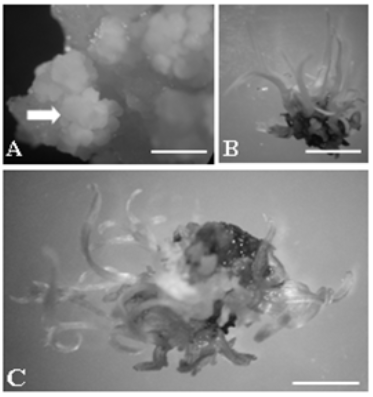Plant regeneration of sugarcane cv. RB931003 and RB98710 from somatic embryos and acclimatization
DOI:
https://doi.org/10.20873/jbb.uft.cemaf.v2n3.dibaxKeywords:
Saccharum spp., 6-benzylaminopurine, ussue culture, somatic embryogenesisAbstract
The aim of this study was to establish a protocol for regeneration and acclimatization of sugarcane (RB931003 and RB98710) cultivars from somatic embryos. For the cultivar RB931003, the concentration of 0.25 mg L-1 BAP was efficient and provided the shoot induction in 80% of embryogenic masses. For the cultivar RB98710, the highest percentage of shoot induction was observed in 0 and 0.25 mg L-1 BAP, which promoted 70% and 75% of shoots from embryogenic masses, respectively. The MS medium without growth regulators proved to be appropriate for elongation and rooting of shoots and the use of substrate composed by vermiculite and MS salts was effective in the acclimatization of plants for both cultivars analyzed.
References
Ali, A.; Naz, S.; Siddiqui, F. A.; Iqbal, J. (2008), Rapid clonal multiplication of sugarcane (Saccharum officinarum) through callogenesis and organogenesis. Pakistan Journal of Botany, 40, 123-38.
Alves, S. A. O.; Lemos, O. F. de; Santos Filho, B. G.; Silva, A. L. L. da. (2011), In vitro embryo rescue of interspecific hybrids of oil palm (Elaeis oleifera x Elaeis guineensis). Journal of Biotechnology and Biodiversity, 2, 1-6.
Los Blanco, M. A.; Nieves, N.; Sánchez, M.; Borroto, C. G.; Castillo, R.; González, J. L.; Escalona, M.; Báez, E.; Hernández, Z. (1997), Protein changes associated with plant regeneration in embryogenic calli of sugarcane (Saccharum sp.). Plant cell, Tissue and Organ Culture, 51, 153-58.
Brisibe, E. A.; Miyake, H.; Tanigushi, T.; Maeda, E. (1994), Regulation of somatic embryogenesis in long-terms callus cultures of sugarcane (Saccharum officinarum L.). New Phytologist, 126, 301-7.
CONAB, COMPANHIA NACIONAL DE ABASTECIMENTO (2007) Central de informações agropecuárias: safras – cana. http://www.conab.gov.br. Cited 15 jan 2011.
Falco, M. C.; Mendes, B. M. J.; Beatriz, M.; Tulmann-Neto, A.; Appezzato-Da-Glória, B. (1996), Histological characterization of in vitro regeneration of Saccharum sp. Revista Brasileira de Fisiologia Vegetal, 8, 93-7.
Fitch, M. M. M.; Moore, P. H. (1990), Comparison of 2,4-D and picloram for selection of long-term totipotent green callus of sugarcane. Plant Cell, Tissue and Organ Culture, 20, 157-63.
Franklin, G.; Arvinth, S.; Sheeba, C. J.; Kanchana, M.; Subramonian, N. (2006), Auxin pretreatment promotes regeneration of sugarcane (Saccharum spp. Hybrids) midrib segment explants. Plant Growth Regulation, 50, 111-19.
Hendre, R. R.; Gupta, V. S.; Mascarenhas, A. F.; Ranjekar, P. K. (1993) Differences in repeated DNA sequences between callus and shoot tissue of sugarcane (Saccharum officinarum L.). Indian Journal of Biochemistry and Biophysics, 23, 80- 86.
Ho, J.; Vasil, I. K. (1983), Somatic embryogenesis in sugarcane (Saccharum officinarum): The morphology and physiology of callus formation and the ontogeny somatic embryos. Protoplasma, 118, 169-80.
Lamb, C. R. C.; Milach, S. C. K.; Pasquali, G.; Barro, R. S. (2001) Regeneração de plantas a partir de segmentos de base de folhas de aveia.

Published
How to Cite
Issue
Section
License
Copyright (c) 2024 - Journal of Biotechnology and Biodiversity

This work is licensed under a Creative Commons Attribution 4.0 International License.
Authors who publish with this journal agree to the following terms:
Authors retain copyright and grant the journal right of first publication with the work simultaneously licensed under a Creative Commons Attribution License (CC BY 4.0 at http://creativecommons.org/licenses/by/4.0/) that allows others to share the work with an acknowledgement of the work's authorship and initial publication in this journal.
Authors are able to enter into separate, additional contractual arrangements for the non-exclusive distribution of the journal's published version of the work (e.g., post it to an institutional repository or publish it in a book), with an acknowledgement of its initial publication in this journal.
Authors are permitted and encouraged to post their work online (e.g. in institutional repositories or on their website) prior to and during the submission process, as it can lead to productive exchanges, as well as earlier and greater citation of published work (Available at The Effect of Open Access, at http://opcit.eprints.org/oacitation-biblio.html).


